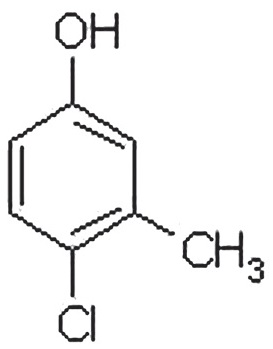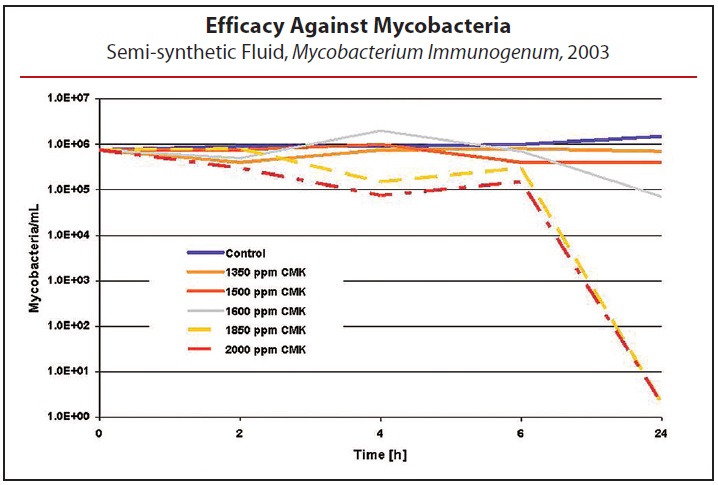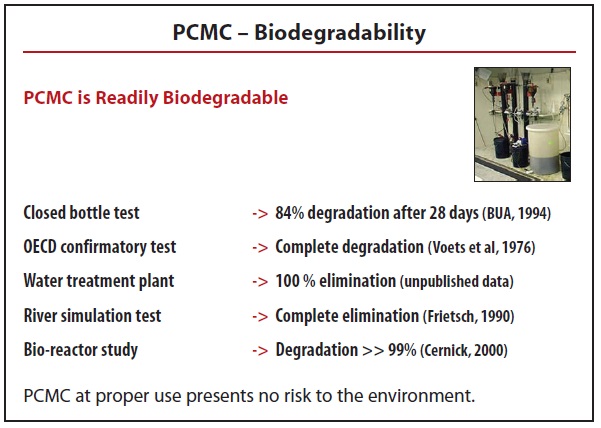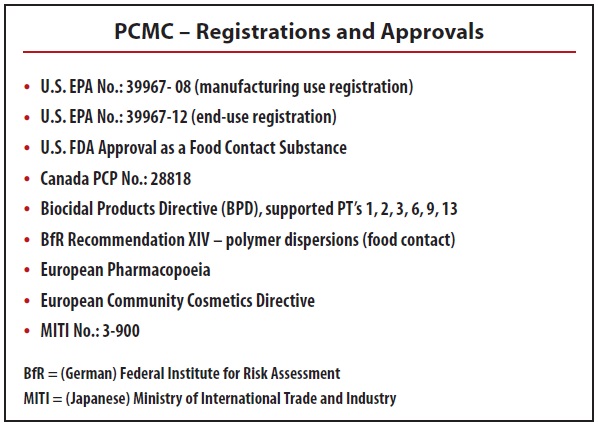Parachlorometacresol (PCMC) has been on the market for several decades as a highly effective and safe biocide, and is registered in many regions of the world for use in metalworking fluids and lubricants. LANXESS produces and markets this compound under the trade name PREVENTOL ® CMK Preservative (
Figure 1).
 Figure 1. Structural formula of Parachlorometacresol (PCMC).
Figure 1. Structural formula of Parachlorometacresol (PCMC).
Over the last decade, PCMC, a phenolic active ingredient, has made a comeback in metalworking fluids due to its tailor-made physico-chemical and microbiological properties that allow for effective and sustainable combat against bacteria, mycobacteria and fungi.
Mode of Action
PCMC is a membrane-active microbicide. Phenolic derivatives adsorptively coat the surface of the microbe cell membrane and are more or less dissolved by lipids. They attack biological membranes and penetrate into the cell, where reactions with the protoplasm and the cellular proteins occur. As a result, enzymes are inhibited. It is known that the oxidoreductases and the enzymes of carbohydrate and protein metabolism are particularly sensitive. At low concentrations there is only reversible absorption of the phenolic compound at the cytoplasmic membrane and a bacteriostatic or fungistatic effect is observed. At higher concentrations, the cell membrane is penetrated and destroyed, and the action of PCMC is biocidal.
Efficacy
PCMC’s solubility in water is fair and increases with increasing pH levels. For most formulas the water solubility is sufficient and higher than the effective concentration. It is its solubility in lipophilic environments that makes PCMC such a powerful molecule in mycobacteria control. Mycobacteria have a more hydrophobic cell wall, caused by the presence of mycolic acid (containing long chain aliphatic hydrocarbons). This distinguishes mycobacteria from other bacteria, and gives a more lipophilic agent like PCMC an advantage at penetrating the cell wall versus other chemistries. Levels of 2000 – 2500 ppm PCMC in the fluid are typically applied to prevent mycobacteria growth; similar levels added tank side can be used to cure mycobacteria infections (
Figure 2).
 Figure 2. Efficacy of PREVENTOL® CMK Preservative against MycobacteriumImmunogenum in a semi-synthetic fluid, 2003.
Figure 2. Efficacy of PREVENTOL® CMK Preservative against MycobacteriumImmunogenum in a semi-synthetic fluid, 2003.
The effectiveness of PREVENTOL® CMK Preservative in metalworking fluids, particularly in soluble oils and semi-synthetic formulas, has been demonstrated repeatedly.
Figure 3 displays the result of a 10 week repeated challenge test performed according to ASTM and IBRG protocols. The example illustrates PCMC performance using a mixed inoculum of wild type and IBRG strains of bacteria, yeast and fungi. Plate counts have been carried out weekly before new inoculation.
 Figure 3. Efficacy of PREVENTOL® CMK Preservative against bacteria, yeast and fungi in a soluble oil.
Biodegradability
Figure 3. Efficacy of PREVENTOL® CMK Preservative against bacteria, yeast and fungi in a soluble oil.
Biodegradability
A topic that is surprisingly frequently overlooked when it comes to phenolics is biodegradability. Certainly not all phenols are the same and this holds true for their environmental fate as well. PCMC entering the waste water treatment plants at low concentrations will be biodegraded. PCMC in particular has been tested repeatedly with results that conclude that it is readily biodegradable. Concentrations up to 85 mg/L of PCMC are completely biodegradable and therefore nontoxic to an activated sludge treatment system. A list of experiments performed to demonstrate PCMC biodegradability is shown in
Figure 4.
 Figure 4. Biodegradability of Parachlorometacresol (PCMC).
Registrations and Approvals
Figure 4. Biodegradability of Parachlorometacresol (PCMC).
Registrations and Approvals
In today’s global environment it is crucial to provide manufacturers with the ability to market their products in all regions in which they are interested. As previously mentioned, PREVENTOL® CMK Preservative has been sold for quite some time. As such, a significant number of studies have been conducted, creating a tremendous amount of data. This allows for registrations in all regulated markets, particularly U.S. EPA registrations, Health Canada PMRA registrations, and Product Type listings under the Biocidal Product Directive (BPD) in Europe (
Figure 5).
 Figure 5. Registrations and approvals in regulated markets.
Figure 5. Registrations and approvals in regulated markets.
The latest approval for PREVENTOL® CMK Preservative is for use in incidental food contact lubricants (H1 lubricants). Approvals have been earned from the U.S. FDA and NSF:
•
FDA 21 CFR § 178.3570 FCN No. 560
•
NSF Registration No. 138991
U. S. EPA Registered PCMC Grades
PCMC is available in several delivery forms to provide formulators and users the flexibility they need.
PREVENTOL® CMK Preservative
Solid, pellets
PREVENTOL® CMK-Na Preservative
Solid, flakes
PREVENTOL® CMK 30
Liquid, solution
PREVENTOL® CMK 40
Liquid, solution
In summary, PCMC is a formaldehyde-free, properly registered, safe biocide that is effective against bacteria, fungi and mycobacteria. It is fast-acting and provides long term efficacy due to its excellent chemical and thermal stability. PCMC is soluble in non-polar media as well as in water, giving formulators additional flexibility.
PREVENTOL® is a registered trademark of LANXESS Deutschland GmbH.